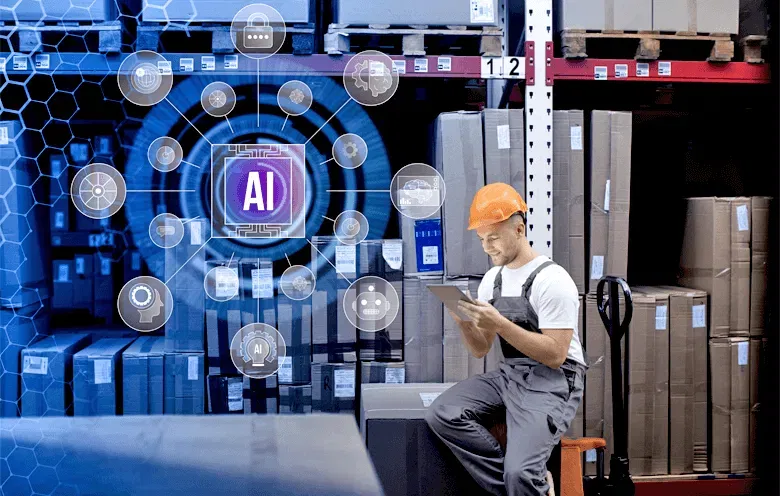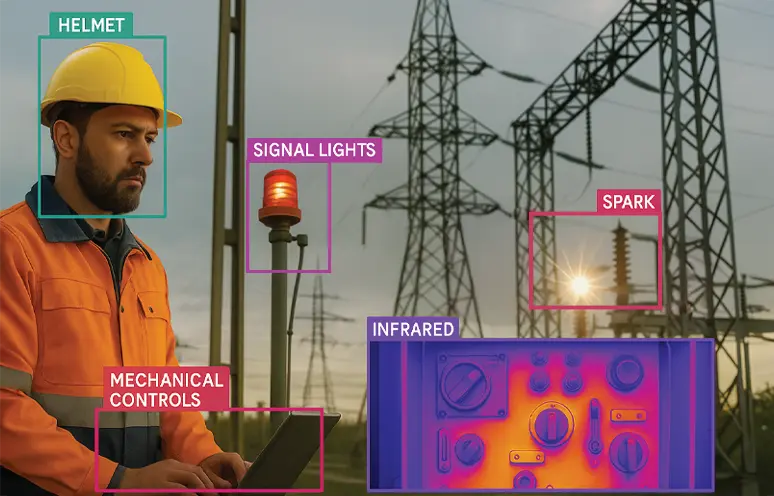Growing demand for real-time insights has driven facility teams to integration of AI and computer vision. These technologies are actively redefining how modern buildings are optimized, maintained, and monitored.
AI and computer vision enable a move from reactive fixes to proactive maintenance through automated surveillance, real-time occupancy tracking, and more. These technologies are no longer futuristic, they are already revolutionizing industry.
In this blog post, we’ll explore how these cutting-edge technologies are transforming facility management, starting with their role in automating surveillance and intrusion detection.
Here we examine how it improves security measures, helps optimize energy consumption, and predicts maintenance needs, ushering in a new era of efficiency and sustainability in facility management.
Before we explore, it may be helpful to read about the powerful applications of computer vision in manufacturing.
How are AI and computer vision transforming facility management?
AI-powered analytics and computer vision are reshaping facility management with real-time insights and automation. These advanced technologies are revolutionizing how you manage your facilities. Here’s why they should matter to you:
- Real-time monitoring: AI and computer vision offers real-time monitoring using cameras and sensors to detect and analyze data, enabling businesses to make proactive decisions, increasing operational efficiency, and space optimization.
- Improved security: Computer vision boost security by automating surveillance that identifies anomalies and potential threats, elevating facility protection.
- Smart energy systems: AI-powered tools make energy systems smarter by analyzing and responding to usage trends. Thus, energy consumption is optimized, reducing costs, and improving sustainability.
- Preventing downtime: AI-powered predictive maintenance prevents equipment failures, reducing downtime, enhancing asset life, and boosting performance.
In essence, computer vision and AI serve as key drivers, bringing a more secure, energy-efficient, and resource-optimized approach to your facility management responsibilities. It enables real-time space monitoring, smarter room allocation, and data-driven resource planning to improve space utilization and reduce waste.
Benefits of computer vision and AI in facility management
Computer vision and AI are revolutionizing facility management by enabling real-time insights, automation, and smarter resource planning. These technologies drive improved efficiency, enhanced safety, and sustainable operations across modern facilities.
1. Space optimization
AI-powered analytics tool offers accurate insights on how space should be utilized across your facility. It helps you optimize layouts and identify underutilized areas by analyzing occupancy patterns, usage trends, and foot traffic. This enables more efficient space utilization by consolidating unused workstations, resizing meeting rooms, or repurposing vacant zones. Making use of AI and computer vision services plays a pivotal role in achieving this goal. Here’s how:
- Optimized layouts: AI-driven space management tools enable real-time space monitoring by analyzing occupancy patterns and data usage. Allowing facility managers to create layouts that maximize space utilization while ensuring easy access to essential resources. In hybrid offices, AI-powered occupancy sensors enable dynamic hot-desking, improving space utilization during fluctuating work hours.
- Dynamic reservation system: The implementation of AI allows for dynamic reservation of office space based on real usage patterns. As a result, it minimizes scheduling conflicts and enhances overall productivity among employees.
- Real-time monitoring and adaptation: AI enables real-time monitoring using adaptive adjustments in lighting, heating, and cooling based on occupancy. Thus, it saves energy when spaces are unoccupied and contributes to sustainability goals.
- Ensuring health and safety: AI-powered cameras and sensors play a crucial role in maintaining social distancing by accurately detecting the number of people in a room, to align with health and safety guidelines.
- Automate efficiency: By automating various tasks, AI helps reduce operational costs, improve employee satisfaction, and create an environment that is flexible and adaptable to changing needs.
2. Predictive maintenance
Traditional facility management follows a reactive approach addressing maintenance only when issues arise. Integrating AI-powered tools enables facility management to adopt a proactive approach that offers solutions before an issue arises. Here’s why AI-powered predictive maintenance, with a focus on computer vision, matters for you:
- Early issue identification: AI algorithms analyze equipment data by identifying early warning signs. Enabling organizations to schedule maintenance proactively, preventing breakdowns and extending equipment lifespan. Moreover, AI offers early fault detection, reducing unexpected downtime.
- Proactive maintenance scheduling: Instead of relying on fixed schedules, predictive maintenance leverages AI to analyze sensor data and historical performance, predicting potential equipment failures.
- Reliability and cost reduction: The outcome is heightened reliability, reduced maintenance costs, and uninterrupted operations. Predictive maintenance services are particularly valuable for critical equipment like HVAC systems, elevators, and manufacturing machinery.
- Energy efficiency and sustainability: AI-driven predictive maintenance tools identify legacy equipment that consumes excess energy. By identifying and eliminating inefficiencies early, you canreduce energy wastage and extend equipment life, lowering utility costs, and supporting sustainability targets.
3. Data ethics and compliance
As AI and computer vision become integral to facility management, organizations must proactively address privacy and ethical concerns. Implementing these technologies responsibly ensures regulatory compliance, protects stakeholder trust, and organizational integrity. Here’s why ethical AI use, with a focus on computer vision, matters to you:
- Transparent and ethical practices: AI systems used in facility management clearly communicate how data is collected, used, and stored, and takes consent when personal data is involved, building trust with stakeholders. Establishing clear policies and guidelines for AI enhances accountability and compliance.
- Balancing surveillance with privacy: Incorporating AI and computer vision for surveillance and data collection requires a delicate balance. It’s essential to respect individual privacy and adhere to regulations.
- Anonymizing and protecting data: Ensure data is anonymized and protected by implementing robust protection measures. This helps prevent unauthorized access or misuse, reinforcing your commitment to ethical practices.
- Stay informed on regulations: Keep yourself updated on evolving privacy laws and regulations concerning AI and data management. This knowledge ensures compliance and demonstrates your dedication to staying within legal and ethical boundaries.
- Building trust: Adhering to best practices ensures compliance, builds trust with employees, tenants, and customers. Demonstrating ethical considerations aligns with corporate values and societal expectations.
Use case of AI and computer vision in facility management
AI and computer vision are revolutionizing facility management by enabling real-time insights, automation, and smarter decision-making. From occupancy tracking to predictive maintenance, these technologies enhance efficiency, safety, and sustainability across operations.
1. People counting and occupancy monitoring
AI-powered tools and computer vision offer real-time occupancy tracking and people counting, enabling facility leaders to monitor room usage and create plans accordingly. These technologies make use of deep learning algorithms to identify people in images and videos. It provides data-driven insights for layout optimization, energy management, and compliance with safety regulations in high-traffic zones.
2. Access control using facial recognition
Computer vision-powered facial recognition technology offers seamless and secure access to restricted zones. This ensures that only authorized individuals get access to restricted zones without physical access. Moreover, this technology provides real-time tracking and alerts in case of unauthorized access, enhancing security and reducing administrative workload.
3. Energy optimization via motion detection
By integrating AI with motion sensors and computer vision, building systems can dynamically adjust lighting and HVAC based on real-time movement and occupancy patterns. When no motion is detected, systems automatically power down or switch to energy-saving modes. This reduces utility costs and aligns with sustainability goals by lowering the facility’s carbon footprint.
4. Workplace safety monitoring (PPE detection, slip and fall alerts)
Computer vision technology and AI-powered cameras can immediately detect workers who are not wearing PPE and immediately report non-compliance. Similarly, accident detection algorithms analyze human postures to recognize incidents in real time and alert authorities instantly. Hence, proactive safety monitoring eliminates injury-related costs, boosts employee morale, and regulatory compliance.
5. Predictive cleaning and maintenance scheduling
Computer vision systems can analyze foot traffic and space usage to predict when and where cleaning is needed. AI algorithms also monitor equipment and infrastructure to anticipate maintenance requirements before failures occur. This demand-driven scheduling model ensures optimal allocation of cleaning crews and maintenance staff, improves cleanliness and uptime, and lowers operational costs through smarter resource management.
Transform Facility Management with Intelligent Vision Solutions
Let’s create a modern, efficient, and resilient infrastructure together.

Real-world use cases of computer vision in facility management
AI and computer vision services are revolutionizing facility management in various ways:
1. Walmart employs AI-powered cameras with computer vision to monitor stores, prevent theft, and enhance security.
- What was implemented: Walmart deployed an AI-based surveillance system known as “Missed Scan Detection” across over 1,000 stores. This system utilizes computer vision to monitor checkouts, identifying instances where items are not scanned properly.
- Why it mattered: Retail theft significantly impacts profitability. By automating the detection of scanning errors and potential theft, Walmart aimed to reduce inventory shrinkage and enhance loss prevention.
- Benefits delivered: The implementation led to improved detection of checkout errors and potential theft, enhancing overall store security and reducing losses.
2. Google optimizes energy consumption in data centers by integrating AI algorithms with computer vision capabilities.
- What was implemented: Google integrated DeepMind’s AI algorithms with computer vision capabilities to manage and optimize cooling systems in its data centers. The AI analyzed data from thousands of sensors to predict and adjust cooling needs in real time.
- Why it mattered: Data centers consume substantial energy, with cooling systems being a major contributor. Optimizing cooling efficiency was crucial for reducing operational costs and environmental impact.
- Benefits delivered: The AI-driven approach achieved a 40% reduction in energy used for cooling and a 15% decrease in overall Power Usage Effectiveness (PUE), marking significant improvements in energy efficiency.
3. Amazon utilizes computer vision through AI to predict equipment failures in its warehouses, ensuring proactive maintenance.
- What was implemented: Amazon employed AI and computer vision technologies to monitor equipment health in its warehouses. By analyzing sensor data, the system could predict potential equipment failures before they occur.
- Why it mattered: Unexpected equipment failures can disrupt operations and lead to delays. Predictive maintenance ensures equipment reliability and operational continuity.
- Benefits delivered: This proactive maintenance approach reduced unplanned downtime, enhanced equipment lifespan, and improved overall warehouse efficiency.
Drive smart, safe, and sustainable facilities with AI and computer vision
AI and computer vision turn raw sensor feeds into actionable insights for occupancy, energy, and maintenance. By implementing AI and computer vision technology, facility managers can access real-time data on occupancy, energy consumption, maintenance logs, and IoT sensors. This empowers leaders to make informed decisions regarding resource allocation, preventive maintenance strategies, and space utilization to stay competitive.

